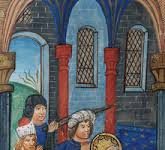The story of Saint Dymphna (7th century), steeped in legend, is not one, perhaps, that parents would feel comfortable telling their children. Dymphna was a lovely young Irish lass, the daughter of Damon, a minor king, of Oriel, experiencing an idyllic upbringing in medieval Ireland, her mother a devout Catholic, as so many Irish used to be. She made a vow of chastity at the age of 14, and it was soon after that, her mother died. Her father, Damon, still perhaps half-pagan, fell into inconsolable grief, and was advised to marry again to pick up his spirits and life. This, the king resolved to do, but only if he could find a woman as beautiful and sweet as his departed wife…And it was then the lust of his eyes fell upon his own daughter.
Dymphna, realizing the horror of what was intended, picked up and fled to Belgium, with her confessor, Father Gerebemus, two servants and, for good measure, the king’s fool. There she lived in exile, using some of the fortune she had brought along – after all, she was a princess – to found a hospice for the sick and dying, back in the days before such were publicly funded. The mad king traced her – or his – coins to where his daughter was, found her, had his servants kill Father Gerebemus (also venerated as a saint) and compelled Dymphna to follow him back to Ireland. She resisted, and in his rage – the bitter fruit of his ungoverned lust – he drew his sword and lopped off her head.
Dymphna was immediately venerated as a saint and martyr, with miracles abounding. In 1349, a church was built in Geel, and pilgrims flocked from all over Europe, seeking help, especially for disorders of the mind. Her shrine became a refuge for them, and they would stay for rest, prayer and help, some for a few months, others for years. So began the formal practice of psychiatry, a spiritual work before a medical one, its etymology the art of healing the ‘soul’. Those considered ‘mad’ were never called patients, but ‘boarders’, and the shrine’s work continued right up to near the middle of the 20th century, and provided the exemplar of our modern institutions. (May 15th, by one of those odd coincidences, also commemorates the founding of the first private mental hospital in Philadelphia in 1817)
There is a fine line – as King Damon evinced – amongst disorders of the soul, of the mind, and of the brain, for we are body-soul composites, persons, and what we do in the body affects our soul, and vice versa. Medicine and spirituality should be ‘holistic’, or we might say integral, taking into account the wholeness of the person. Prayer, humour, friendship, music, love, are all ‘good medicine’, and the healing arts should never be without them, something we are learning in our drab, drear, bland, technocratic, legalistic, humourless, mercenary and even immoral approach to medicine, now so rife.
We must develop immunity not just against viruses and bacteria and disorders of the body, but against sin in all its manifestations, lust, envy, greed, discouragement, despair. Fear not him who can kill the body, but the soul, and cast both into hell.
Saint Dymphna is the patron saint of runaways, those with mental and neurological disorders, victims of incest and sexual assault, and those with depression, anxiety and sleep disorder – Dymphna has her work cut out for her, for their numbers are tragically growing, and she is a fitting intercessor for our times, where so many have lost their God-given marbles and sense of perspective. Unless we see the ‘whole picture’, not just of ourselves, but of God’s creation, which includes not just earth and this life, but heaven and eternal life. But that requires Faith. And as Chesterton once quipped, the mad have not lost their reason – they’ve lost everything except their reason. Atheism always breeds insanity, of one sort or another.
We need never give up hope. I will have no sad saints in my house!, cried Saint Philip Neri, who is called the ‘saint of joy’.
Saint Dymphna, ora pro nobis!
(source: Wikipedia.org)











